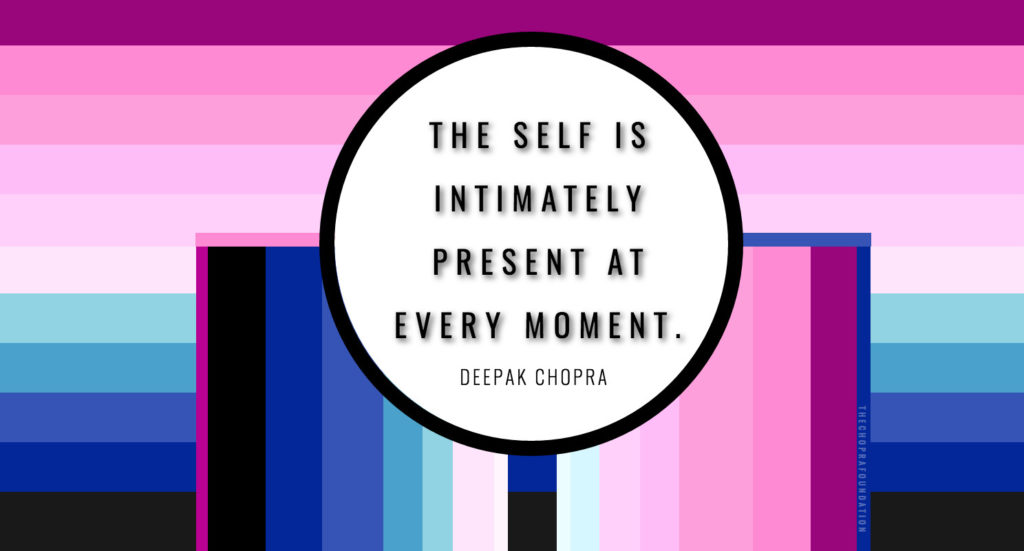By Deepak Chopra, MD
Not many people reflect philosophically on the age-old question, “Who am I?” For practical purposes, everyday life depends on accepting the self that gets up in the morning, eats breakfast, and goes off to work. This makes it seem as if “Who am I?” is a given. But in fact, it isn’t. You are shifting unconsciously from one persona to the next all the time. There is tremendous importance in this fact, because the shifting self isn’t the real you.
The shifting self can be divided into three general identities, three versions of “I.”
The outward self: This is the social persona, which you identify with if your focus is on socially-approved things like money, career, the right neighborhood, an impressive house, etc. “I” is attached to labels that relate to those things, so that “WASP surgeon with a Park Avenue practice, a socialite wife, and a major portfolio” defines a very different self than “Latino working-class single mother living on food stamps.”
The private self: This is who you are behind closed doors. The private self identifies with feelings and relationships. The values that matter most include a happy marriage, satisfying sex life, children to love and be proud of, etc. On the downside are the private trials and miseries that come into every life. “I” is attached to the hopes and fears of everyday existence, which for some people means an existence of insecurity, anxiety, depression, and dashed hopes that seem inescapable.
The subconscious self: This is the self that lies beneath the surface, where repressed feelings, old wounds and traumas, and various hidden forces live. This is a shadowy region that many find dangerous to enter. But here there is also creativity and intuition, so the subconscious self isn’t only about lower or darker impulses. Unlike the outward and private self, there is no well-defined “I” in the subconscious. Most people are unaware of their deepest drives, desires, and fears because unless there is a sudden outbreak from here, they’d rather keep the subconscious self hidden, even from themselves.

The “I” you identify with is like a magnifying glass gathering the sun’s rays to a point. Your “I” interprets every experience and makes it personal. “I” is a bundle of hopes, fears, wishes, and reams. “I” harbors memories no one else has, and in the compartments of memory are stored habits, beliefs, old traumas, and past conditioning. This multiplicity is bewildering, which is why the teaching of “Know thyself” is actually the point of being alive—until you know where “I” came from, you cannot discover who you really are.
In the world’s wisdom traditions, the three versions of “I” are called the divided self, and a person can be trapped inside it for a lifetime. But the divided self serves as a disguise from the real self, which is sometimes known as the higher self or simply the Self with a capital S. The secret to the Self is that it is made from the same “stuff” as the divided self, the stuff of consciousness. It only takes awareness for the mind to exist, going about its business of thinking, feeling, and sensing the world. But with the divided self, this “stuff” is constantly taking shape. We mistake our thoughts, feelings, and sensations as the whole story.
Yet if you take away all the shapes that consciousness turns into, the is another kind of experience, of inner silence without any content. This alone deserves to be called the Self. It is the pure experiencer, devoid of mental or physical activity, needing nothing to identify with except its own being. It’s odd that this is who we are, and people need convincing, because the allure of the divided self is powerful; in addition, it’s the only self–or three selves–we’ve been used to all our lives.
Yet if the Self is the correct answer to “Who am I?” it must be present here and now. Which means that the higher states of consciousness that is our birthright, the source of love, compassion, creativity, intelligence, and evolution, can’t simply be faraway ideals. They are attributes of who we really are. This is the main teaching of the worlds wisdom traditions, and the seers, saints, sages, and spiritual guides revered in every culture are no more than people who found the right answer to “Who am I?” In that light, there is only one discovery to make along the spiritual path, the discovery that the Self is intimately present at every moment. Being the source of everything, it cannot change. It cannot come and go.
The only thing that changes is our perception and understanding. The three selves we identify with right this moment are only perceptions, constructs or models we hold in our heads. Abandon the constructs, and what is left is the “real” reality, the field of pure consciousness. In the practice of meditation perception shifts closer to the source of awareness. That is the open door through which the self is glimpsed, and with time and attention, the divided self melts away leaving only the unified Self. In that process lies the whole story of answering “who am I?”
Deepak Chopra MD, FACP, founder of The Chopra Foundation and co-founder of The Chopra Center for Wellbeing, is a world-renowned pioneer in integrative medicine and personal transformation, and is Board Certified in Internal Medicine, Endocrinology and Metabolism. He is a Fellow of the American College of Physicians and a member of the American Association of Clinical Endocrinologists. Chopra is the author of more than 80 books translated into over 43 languages, including numerous New York Times bestsellers. His latest books are Super Genes co-authored with Rudy Tanzi, Ph.D. and Quantum Healing (Revised and Updated): Exploring the Frontiers of Mind/Body Medicine. www.deepakchopra.com
